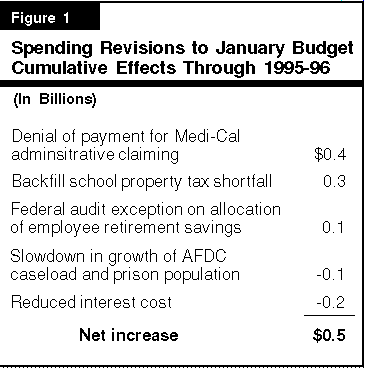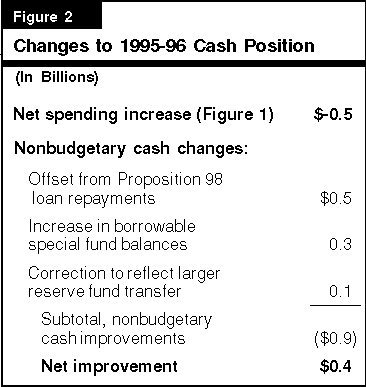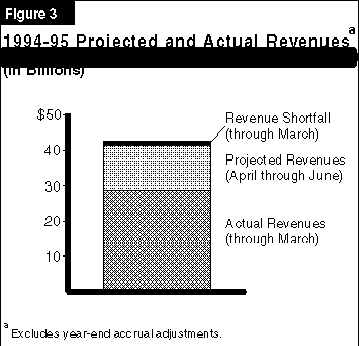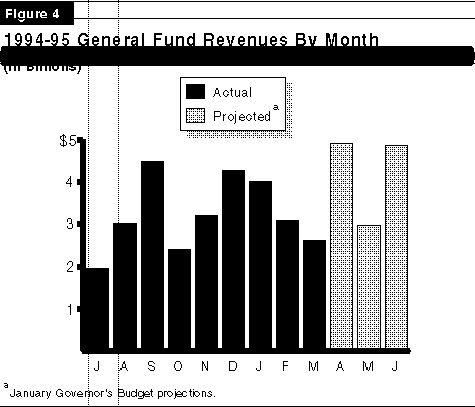Legislative Analyst's Office, April 1995

Budget and Cash Developments
In this Update, we identify and discuss major changes to the state's budget outlook and cash position which have occurred since the Governor's 1995-96 budget was submitted in January. In mid-May the Department of Finance will release the administration's May Revision to its January budget proposal. The May Revision will include a comprehensive update of the revenue and spending estimates presented in the January budget, as well as a revised projection of the state's cash position through 1995-96. This Update presents a preview of some of the major budget-related changes that have occurred since January and their implications for the state's current budget outlook and cash projections. Shortly after the May Revision is released we will present our assessment of the revised budget proposal, including a reassessment of the budget's risks and assumptions, and a discussion of any issues for legislative consideration raised by the budget revisions.
Increased Spending
Figure 1 lists major spending changes to the January budget that we have identified at this point. The amounts shown include both 1994-95 and 1995-96 fiscal impacts. Spending increases total $0.8 billion, while identified savings total $0.3 billion-- leaving a net spending increase of about $0.5 billion.

Medi-Cal Administrative Claiming--$0.4 billion cost. The January budget includes $200 million annually in reimbursements from counties in 1994-95 and 1995-96 to offset General Fund Medi-Cal costs. These reimbursements were assumed in the 1994-95 budget agreement, based on the expectation that counties would receive substantial additional federal funds for administrative and case-management activities associated with the Medi-Cal program. However, the federal government denied payment of these claims in January. Although this denial is subject to appeal, it appears likely that there will be at least a substantial shortfall in these reimbursements.
Local Property Tax Shortfalls--$0.3 billion cost. Under current fiscal conditions, Proposition 98 requires the state to backfill shortfalls in property tax revenues received by public schools and community colleges. Based on current trends, the state will have to provide a total of about $0.3 billion of additional funding to schools and community colleges through 1995-96 in order to make up for lower property tax revenues.
Federal Audit Exception--$0.1 billion cost. For several years, the state used excess earnings that had accumulated in the "IDDA/EPDA" accounts within the Public Employees Retirement System (PERS) to offset General Fund costs for employee retirement contributions. A recent federal audit, however, has found that a share of those savings should have been allocated to federal programs that support state employees. The federal audit estimates that the amount currently owed to federal programs by the state is $140 million.
Interest Costs and Caseloads--$0.3 billion savings. We estimate that the January budget overstates interest costs for short-term borrowing by $0.2 billion through 1995-96. Also, AFDC welfare caseloads and prison inmate populations appear to be growing somewhat more slowly than budget projections for a two-year savings of about $0.1 billion.
Budget Implications
The January budget proposal projected a 1995-96 budget reserve of $92 million (compared with General Fund spending of $41.7 billion). The net spending increase that we have identified would eliminate that reserve and require several hundred million dollars of additional savings or revenues to avoid a deficit in 1995-96. The actual extent of any additional budget problem will become clearer upon the release of the comprehensive update of spending and revenue estimates in the May Revision. Current developments involving revenues are discussed later in this Update.
Other Adjustments Improve State's Cash Outlook
The state's cash position determines whether additional borrowing will be needed in order for the state to pay its bills in a timely manner, and whether automatic spending cuts will be required in 1995-96 under last year's "trigger" legislation. The January budget proposal estimated that the General Fund would end 1995-96 with a cash "cushion" of about $1 billion of unused borrowing capacity from special fund balances. The net spending increase in Figure 1 would reduce the size of that cushion. However, we also have identified three adjustments which improve the January cash projection. As shown in Figure 2, these adjustments total $0.9 billion, which means they more than offset the negative cash impact of the net spending increase identified in Figure 1.

The largest adjustment adds $0.5 billion to the 1995-96 ending cash balance for Proposition 98 loan repayments. The impact of these repayments was not reflected in the cash projections in the January budget. An increase in borrowable special fund balances and a correction to a reserve fund transfer increase the cash cushion by an additional $0.3 billion and $0.1 billion, respectively. The combined effect of the spending increases and the cash changes is to improve the state's 1995-96 cash position by about $0.4 billion. This cash improvement will make financing the 1995-96 budget somewhat easier, even with the spending increases that we have identified above.
Contact Dan Rabovsky, 324-4942 or at [email protected]
Economic and Revenue Developments
March Revenues Down Modestly
California's economy continued to expand in March, experiencing an increase of 17,000 jobs. Although job growth was less than in February and unemployment rose slightly, this partly reflects March's severe storm conditions, and the economic recovery remains "on track." General Fund revenues for the month of March were $28 million below the forecast of $2.6 billion. Figure 3 shows that this brought the cumulative 1994-95 revenue shortfall through March to $110 million.

The main soft spot in March receipts involved sales and use taxes, which were down $91 million for the month. The extent to which this reflects underlying weakness in taxable sales versus temporary softness due to the recent floods is presently unknown. March personal income tax receipts were on target, with a modest shortfall in withholding being offset by lower-than-expected refunds. Regarding the third largest revenue source, March's corporate tax receipts were $42 million more than forecast.
The $110 million cumulative revenue shortfall through March reflects a net shortfall in taxes of $294 million partially offset by a $184 million gain from nontax revenues such as fines and unclaimed property receipts. This nontax gain appears to be permanent.
April FTB Deposits Meet Forecast
As seen in Figure 4, April is projected to be the year's largest revenue month with over $4.9 billion expected. Nearly 70 percent of these receipts--$3.4 billion--come from tax prepayments and final tax payments paid directly to the Franchise Tax Board by personal income and corporate income taxpayers. These payments were due on April 17. As of April 26 these combined payments had met expectations. Corporate payments were above, and personal income tax payments below, the forecast.

How April revenues end up will depend largely on the performance of withholding, income tax refunds, sales taxes and insurance prepayments. Data on these components will be available during the first week of May.
Figures 3 and 4 indicate that although there are only two months left in 1994-95, a substantial amount of revenues--$7.9 billion--are expected in these months. This includes $4.9 billion in June
Contact --David Vasche/Kristin Szakaly--324-4942; [email protected] or [email protected]
Return to LAO Home Page
�



